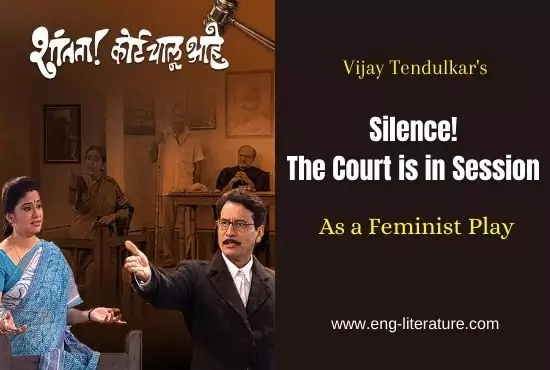Silence! The Court is in Session as a Feminist Play
The representation of woman in texts, both literary and non-literary, has concerned feminist critics since the early 1960s. Many feminists, such as Kate Millett, focused on the stereotypical representations of women, either as sex objects or as adjuncts to male, which are frequently traced in a wide range of texts. Much of this early criticism was concerned with attacking these images for their sexism and, in their place, proposing more positive images of women. This type of feminist criticism went on to celebrate those positive images found in literature which could be used as ‘role models’ for women readers.
But while there are problems with simply analyzing representations of women and judging them to be authentic or as role models, the question of representation is still very much at the forefront of feminist debates. Like Alice Jardine, many have drawn on critical theories such as psychoanalysis in order to discuss representations without assuming that there is a simple link between the textual depiction of female characters and women in the real world. Jardine and other feminist critics who draw on psychoanalytic theory see feminine as an integral and disturbing part of every literary text. This is how it has often been described within psychoanalytic theory by Freud or Lacan, but feminist critics see the feminine as a place of positive instability, denying it the negative polarization which it has been largely accorded by the male critics.
Silence! The Court is in Session is a text written by Vijay Tendulkar, an Indian playwright, in Marathi language at a time when in Western countries women were shouting slogan-personal is political for their freedom from patriarchal domination and when the nationalist ideology on woman question, which required women to preserve the inner sanctum in the private sphere keeping them aloof from Western norms of life, was found to be challenged by women’s demand for equality with men.
Finding enough time in hand before the enactment of the play dealing with the mock-trial of American President Johnson, a group of amateur players organize a rehearsal of the mock-trial of an unmarried woman with a serious charge of infanticide against her in order to serve two purposes: first, to pass time before the enactment of the regular play: secondly, to give Samant a lesson about the proceedings of the court. What began as a game has evolved into hunt. Benare’s colleagues turn into her predators and she becomes a prey to them. The group, the accuser and the judge roll into one. They torture her in the witness-box through fretting interrogations and evidences. Drawing on the patriarchal ideologies that mother and motherland are higher than heaven and that woman is not fit for independence the prosecutor convinces the judge that Benare has committed a serious crime by becoming mother without marriage. He justifies before the judge that motherhood without marriage has always been considered a great sin by ‘our religion and our traditions’. He also persuades the judge to believe that bringing up the child of an illegal union is certainly more horrifying than infanticide.
The judge valorizing social customs over individual freedom passes a savage sentence: the baby in womb must be destroyed along with the loss of her teaching job. The judge remains silent about the intellectual, Prof Damle who has landed the woman in precarious condition by his refusal to be the father of the unborn baby. So the entire text of the mock-trial is masculine.
However, the stability of the masculine text gets disturbed by Benare’s refusal to be governed by the patriarchal judgment. Not only that, the stability of the text is also jolted by her sobbing and silence over which the patriarchal narrative loses control. In addition, Samant’s act of putting the green cloth parrot in front of Benare shows split in patriarchal judgment. In opposition to the savage patriarchal judgment, Samant’s act of putting the parrot seems to betray feminine attributes such as c for other, modesty and sympathy for the oppressed and marginalized woman.
Also Read:
Finally, the patriarchal narrative loses complete control over a feminine space created by the last lullaby of Benare which springs from the deepest layer of her psyche. It echoes the primeval song of the Mother once she heard and preserved alive in her heart as all women keep alive the first voice of love in them. Since it is couched in feminine terms, it reconstructs social relationships that overturn the existing oppressive masculine culture by dismantling the fixed oppositions (self/other, man/the woman). The song is heard wafting ‘from somewhere unseen’- the unseen place may be construed as the no-man’s land. It is a concept developed by Shirley and Edwin Ardener and later drawn on by Alaine Showalter to describe the space occupied by women which is seen to be outside the norms of society. In this space the bond between mother and son is valorized denigrating the role of the males who try to oppose and spoil that relational bond.
The song is the feminine voice that bubbles through the surface of masculine authority. In making Benare call her oppressor crow, Tendulkar challenges patriarchal authority with an implicit question: if the crow is not ousted from the inner sanctum of the society, how can the purity of the society be preserved? Thus the text of the play contains knowledges other than patriarchal dominant knowledge. Though these knowledges are repressed and subjugated, they linger on the margin to disturb the stability and integrity of the patriarchal authority.

Hello, Viewers! Besides being the Founder and Owner of this website, I am a Government Officer. As a hardcore literary lover, I am pursuing my dream by writing notes and articles related to Literature. Drop me a line anytime, whether it’s about any queries or demands or just to share your well-being. I’d love to hear from you. Thanks for stopping by!

Short but appropriate commentary.